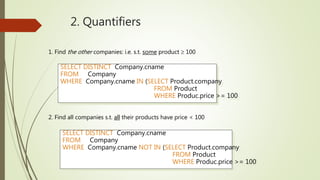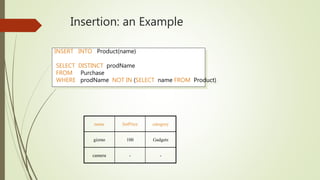Database Management System - SQL Advanced Training
- 1. Database Management System Advanced Training Practices in 2017 Prepared by: Moutasm Tamimi Using SQL language Microsoft SQL Server Management Studio Versions (2008-2010-2012-2014)
- 2. Speaker Information Moutasm tamimi Independent consultant , IT Researcher , CEO at ITG7 Instructor of: Project Development. DBMS. .NET applications. Digital marketing. Email: [email protected] LinkedIn: click here.
- 4. Joins PName Price Category Manufacturer Gizmo $19.99 Gadgets GizmoWorks Powergizmo $29.99 Gadgets GizmoWorks SingleTouch $149.99 Photography Canon MultiTouch $203.99 Household Hitachi Product Company Cname StockPrice Country GizmoWorks 25 USA Canon 65 Japan Hitachi 15 Japan PName Price SingleTouch $149.99 SELECT PName, Price FROM Product, Company WHERE Manufacturer=CName AND Country=‘Japan’ AND Price <= 200
- 5. More Joins Product (pname, price, category, manufacturer) Company (cname, stockPrice, country) Find all Chinese companies that manufacture products both in the ‘electronic’ and ‘toy’ categories SELECT cname FROM WHERE
- 6. Cross Join There are two tables A and B A has a column Id and data (1,2,3) B has a column Id and data (A,B) If I put Select A.Id, B.Id from A,B This generates output as A 1 B 1 C 1 A 2 B 2 C 2
- 7. Self Join There is a table called Emp with the following structure: empid ename mgrid 1 A null 2 B 1 3 C 1 4 D 2 If I want to print all managers using self join, I should write quey as: select e1.ename from emp e1,emp e2 where e1.mgrid = e2.empid
- 8. Inner Join I have 2 tables Student(sid,Name) and Marks(Sid,Subject,Score) If I want to print the marks of all students in the following format, Name Subject Score Select Name,Subject,Score from Student s join Marks m On s.sid = m.sid
- 9. Outer Join Right outer Join Print all the records in the second table with null values for missing records in the first table Left outer Join Print all the records in the first table with null values for missing records in the second table Full outer Join Prints all records in both the table with null values for missing records in both the table
- 10. Left Outer Join I have a table Employee (Eid, Ename, Mid) and a table Machine (Mid,ManufacturerName) Employee EidEName Mid 1 ABC1 2 DEF 3 Machine Mid ManufacturerName 1 Zenith 2 HP
- 11. Left Outer Join I want to print the employee name and machine name. If I write a query using inner join, then the second employee will not be displayed as the mid in his record is not avilable with the second table. So I go for left outer join. The query is as shown below: Select Ename, ManufacturerName from Employee e left outer join Machine m on e.Mid = m.Mid
- 12. Right outer Join Assume data in the tables like this: Employee EidEName Mid 1 ABC1 2 DEF Machine Mid ManufacturerName 1 Zenith 2 HP
- 13. Right Outer Join If I want to find which machine is unallocated, I can use right outer join. The query is as follows: Select Ename, ManufacturerName from Employee e right outer join Machine m on e.Mid = m.Mid This yields a result ABCZenith HP
- 14. Full Outer Join Assume data in the tables like this: Employee EidEName Mid 1 ABC 1 2 DEF 3 GHI 2 Machine Mid ManufacturerName 1 Zenith 2 HP 3 Compaq
- 15. Full Outer Join If I want to find people who have been un allocated with a system and machines that are been un allocated, I can go for full outer join. Query is like this: Select Ename, ManufacturerName from Employee e full outer join Machine m on e.Mid = m.Mid This yields a result ABC Zenith DEF GHIHP Compaq
- 16. Tuple Variables SELECT DISTINCT pname, address FROM Person, Company WHERE worksfor = cname Which address ? Person(pname, address, worksfor) Company(cname, address) SELECT DISTINCT Person.pname, Company.address FROM Person, Company WHERE Person.worksfor = Company.cname SELECT DISTINCT x.pname, y.address FROM Person AS x, Company AS y WHERE x.worksfor = y.cname
- 17. SQL Functions SQL Avg() SQL Count() SQL First() SQL Last() SQL Max() SQL Min() SQL Sum() SQL Group By • SQL HavingSQL Ucase() • SQL Lcase() • SQL Mid() • SQL Len() • SQL Round() • SQL Now() • SQL Format()
- 18. Aggregation SELECT count(*) FROM Product WHERE year > 1995 Except count, all aggregations apply to a single attribute SELECT avg(price) FROM Product WHERE maker=“Toyota” SQL supports several aggregation operations: sum, count, min, max, avg
- 19. COUNT applies to duplicates, unless otherwise stated: SELECT Count(category) FROM Product WHERE year > 1995 same as Count(*) We probably want: SELECT Count(DISTINCT category) FROM Product WHERE year > 1995 Aggregation: Count
- 20. Purchase(product, date, price, quantity) More Examples SELECT Sum(price * quantity) FROM Purchase SELECT Sum(price * quantity) FROM Purchase WHERE product = ‘bagel’ What do they mean ?
- 21. Simple Aggregations Purchase Product Date Price Quantity Bagel 10/21 1 20 Banana 10/3 0.5 10 Banana 10/10 1 10 Bagel 10/25 1.50 20 SELECT Sum(price * quantity) FROM Purchase WHERE product = ‘bagel’ 50 (= 20+30)
- 22. Grouping and Aggregation Purchase(product, date, price, quantity) SELECT product, Sum(price*quantity) AS TotalSales FROM Purchase WHERE date > ‘10/1/2005’ GROUP BY product Let’s see what this means… Find total sales after 10/1/2005 per product.
- 23. Grouping and Aggregation 1. Compute the FROM and WHERE clauses. 2. Group by the attributes in the GROUPBY 3. Compute the SELECT clause: grouped attributes and aggregates.
- 24. 1&2. FROM-WHERE-GROUPBY Product Date Price Quantity Bagel 10/21 1 20 Bagel 10/25 1.50 20 Banana 10/3 0.5 10 Banana 10/10 1 10
- 25. 3. SELECT SELECT product, Sum(price*quantity) AS TotalSales FROM Purchase WHERE date > ‘10/1/2005’ GROUP BY product Product Date Price Quantity Bagel 10/21 1 20 Bagel 10/25 1.50 20 Banana 10/3 0.5 10 Banana 10/10 1 10 Product TotalSales Bagel 50 Banana 15
- 26. GROUP BY v.s. Nested Quereis SELECT product, Sum(price*quantity) AS TotalSales FROM Purchase WHERE date > ‘10/1/2005’ GROUP BY product SELECT DISTINCT x.product, (SELECT Sum(y.price*y.quantity) FROM Purchase y WHERE x.product = y.product AND y.date > ‘10/1/2005’) AS TotalSales FROM Purchase x WHERE x.date > ‘10/1/2005’
- 27. Another Example SELECT product, sum(price * quantity) AS SumSales max(quantity) AS MaxQuantity FROM Purchase GROUP BY product What does it mean ?
- 28. HAVING Clause SELECT product, Sum(price * quantity) FROM Purchase WHERE date > ‘10/1/2005’ GROUP BY product HAVING Sum(quantity) > 30 Same query, except that we consider only products that had at least 100 buyers. HAVING clause contains conditions on aggregates.
- 29. General form of Grouping and Aggregation SELECT S FROM R1,…,Rn WHERE C1 GROUP BY a1,…,ak HAVING C2 S = may contain attributes a1,…,ak and/or any aggregates but NO OTHER ATTRIBUTES C1 = is any condition on the attributes in R1,…,Rn C2 = is any condition on aggregate expressions Why ?
- 30. General form of Grouping and Aggregation Evaluation steps: 1. Evaluate FROM-WHERE, apply condition C1 2. Group by the attributes a1,…,ak 3. Apply condition C2 to each group (may have aggregates) 4. Compute aggregates in S and return the result SELECT S FROM R1,…,Rn WHERE C1 GROUP BY a1,…,ak HAVING C2
- 31. Advanced SQLizing 1. Getting around INTERSECT and EXCEPT 2. Quantifiers 3. Aggregation v.s. subqueries
- 32. 1. INTERSECT and EXCEPT: (SELECT R.A, R.B FROM R) INTERSECT (SELECT S.A, S.B FROM S) SELECT R.A, R.B FROM R WHERE EXISTS(SELECT * FROM S WHERE R.A=S.A and R.B=S.B) (SELECT R.A, R.B FROM R) EXCEPT (SELECT S.A, S.B FROM S) SELECT R.A, R.B FROM R WHERE NOT EXISTS(SELECT * FROM S WHERE R.A=S.A and R.B=S.B) If R, S have no duplicates, then can write without subqueries (HOW ?) INTERSECT and EXCEPT: not in SQL Server
- 33. 2. Quantifiers Product ( pname, price, company) Company( cname, city) Find all companies that make some products with price < 100 SELECT DISTINCT Company.cname FROM Company, Product WHERE Company.cname = Product.company and Product.price < 100 Existential: easy !
- 34. 2. Quantifiers Product ( pname, price, company) Company( cname, city) Find all companies s.t. all of their products have price < 100 Universal: hard ! Find all companies that make only products with price < 100 same as:
- 35. 2. Quantifiers 2. Find all companies s.t. all their products have price < 100 1. Find the other companies: i.e. s.t. some product 100 SELECT DISTINCT Company.cname FROM Company WHERE Company.cname IN (SELECT Product.company FROM Product WHERE Produc.price >= 100 SELECT DISTINCT Company.cname FROM Company WHERE Company.cname NOT IN (SELECT Product.company FROM Product WHERE Produc.price >= 100
- 36. 3. Group-by v.s. Nested Query Find authors who wrote 10 documents: Attempt 1: with nested queries SELECT DISTINCT Author.name FROM Author WHERE count(SELECT Wrote.url FROM Wrote WHERE Author.login=Wrote.login) > 10 This is SQL by a novice Author(login,name) Wrote(login,url)
- 37. 3. Group-by v.s. Nested Query Find all authors who wrote at least 10 documents: Attempt 2: SQL style (with GROUP BY) SELECT Author.name FROM Author, Wrote WHERE Author.login=Wrote.login GROUP BY Author.name HAVING count(wrote.url) > 10 This is SQL by an expert No need for DISTINCT: automatically from GROUP BY
- 38. 3. Group-by v.s. Nested Query Find authors with vocabulary 10000 words: SELECT Author.name FROM Author, Wrote, Mentions WHERE Author.login=Wrote.login AND Wrote.url=Mentions.url GROUP BY Author.name HAVING count(distinct Mentions.word) > 10000 Author(login,name) Wrote(login,url) Mentions(url,word)
- 39. Two Examples Store(sid, sname) Product(pid, pname, price, sid) Find all stores that sell only products with price > 100 same as: Find all stores s.t. all their products have price > 100)
- 40. SELECT Store.name FROM Store, Product WHERE Store.sid = Product.sid GROUP BY Store.sid, Store.name HAVING 100 < min(Product.price) SELECT Store.name FROM Store WHERE Store.sid NOT IN (SELECT Product.sid FROM Product WHERE Product.price <= 100) SELECT Store.name FROM Store WHERE 100 < ALL (SELECT Product.price FROM product WHERE Store.sid = Product.sid) Almost equivalent… Why both ?
- 41. Two Examples Store(sid, sname) Product(pid, pname, price, sid) For each store, find its most expensive product
- 42. Two Examples SELECT Store.sname, max(Product.price) FROM Store, Product WHERE Store.sid = Product.sid GROUP BY Store.sid, Store.sname SELECT Store.sname, x.pname FROM Store, Product x WHERE Store.sid = x.sid and x.price >= ALL (SELECT y.price FROM Product y WHERE Store.sid = y.sid) This is easy but doesn’t do what we want: Better: But may return multiple product names per store
- 43. Two Examples SELECT Store.sname, max(x.pname) FROM Store, Product x WHERE Store.sid = x.sid and x.price >= ALL (SELECT y.price FROM Product y WHERE Store.sid = y.sid) GROUP BY Store.sname Finally, choose some pid arbitrarily, if there are many with highest price:
- 44. NULLS in SQL Whenever we don’t have a value, we can put a NULL Can mean many things: Value does not exists Value exists but is unknown Value not applicable Etc. The schema specifies for each attribute if can be null (nullable attribute) or not How does SQL cope with tables that have NULLs ?
- 45. Null Values If x= NULL then 4*(3-x)/7 is still NULL If x= NULL then x=“Joe” is UNKNOWN In SQL there are three boolean values: FALSE = 0 UNKNOWN = 0.5 TRUE = 1
- 46. Null Values C1 AND C2 = min(C1, C2) C1 OR C2 = max(C1, C2) NOT C1 = 1 – C1 Rule in SQL: include only tuples that yield TRUE SELECT * FROM Person WHERE (age < 25) AND (height > 6 OR weight > 190) E.g. age=20 heigth=NULL weight=200
- 47. Null Values Unexpected behavior: Some Persons are not included ! SELECT * FROM Person WHERE age < 25 OR age >= 25
- 48. Null Values Can test for NULL explicitly: x IS NULL x IS NOT NULL Now it includes all Persons SELECT * FROM Person WHERE age < 25 OR age >= 25 OR age IS NULL
- 49. Outerjoins Explicit joins in SQL = “inner joins”: Product(name, category) Purchase(prodName, store) SELECT Product.name, Purchase.store FROM Product JOIN Purchase ON Product.name = Purchase.prodName SELECT Product.name, Purchase.store FROM Product, Purchase WHERE Product.name = Purchase.prodName Same as: But Products that never sold will be lost !
- 50. Outerjoins Left outer joins in SQL: Product(name, category) Purchase(prodName, store) SELECT Product.name, Purchase.store FROM Product LEFT OUTER JOIN Purchase ON Product.name = Purchase.prodName
- 51. Name Category Gizmo gadget Camera Photo OneClick Photo ProdName Store Gizmo Wiz Camera Ritz Camera Wiz Name Store Gizmo Wiz Camera Ritz Camera Wiz OneClick NULL Product Purchase
- 52. Application Compute, for each product, the total number of sales in ‘September’ Product(name, category) Purchase(prodName, month, store) SELECT Product.name, count(*) FROM Product, Purchase WHERE Product.name = Purchase.prodName and Purchase.month = ‘September’ GROUP BY Product.name What’s wrong ?
- 53. Application Compute, for each product, the total number of sales in ‘September’ Product(name, category) Purchase(prodName, month, store) SELECT Product.name, count(*) FROM Product LEFT OUTER JOIN Purchase ON Product.name = Purchase.prodName and Purchase.month = ‘September’ GROUP BY Product.name Now we also get the products who sold in 0 quantity
- 54. Outer Joins Left outer join: Include the left tuple even if there’s no match Right outer join: Include the right tuple even if there’s no match Full outer join: Include the both left and right tuples even if there’s no match
- 55. Modifying the Database Three kinds of modifications Insertions Deletions Updates Sometimes they are all called “updates”
- 56. Insertions General form: Missing attribute NULL. May drop attribute names if give them in order. INSERT INTO R(A1,…., An) VALUES (v1,…., vn) INSERT INTO Purchase(buyer, seller, product, store) VALUES (‘Joe’, ‘Fred’, ‘wakeup-clock-espresso-machine’, ‘The Sharper Image’) Example: Insert a new purchase to the database:
- 57. Insertions INSERT INTO PRODUCT(name) SELECT DISTINCT Purchase.product FROM Purchase WHERE Purchase.date > “10/26/01” The query replaces the VALUES keyword. Here we insert many tuples into PRODUCT
- 58. Insertion: an Example prodName is foreign key in Product.name Suppose database got corrupted and we need to fix it: name listPrice category gizmo 100 gadgets prodName buyerName price camera John 200 gizmo Smith 80 camera Smith 225 Task: insert in Product all prodNames from Purchase Product Product(name, listPrice, category) Purchase(prodName, buyerName, price) Purchase
- 59. Insertion: an Example INSERT INTO Product(name) SELECT DISTINCT prodName FROM Purchase WHERE prodName NOT IN (SELECT name FROM Product) name listPrice category gizmo 100 Gadgets camera - -
- 60. Insertion: an Example INSERT INTO Product(name, listPrice) SELECT DISTINCT prodName, price FROM Purchase WHERE prodName NOT IN (SELECT name FROM Product) name listPrice category gizmo 100 Gadgets camera 200 - camera ?? 225 ?? - Depends on the implementation
- 61. Deletions DELETE FROM PURCHASE WHERE seller = ‘Joe’ AND product = ‘Brooklyn Bridge’ Factoid about SQL: there is no way to delete only a single occurrence of a tuple that appears twice in a relation. Example:
- 62. Updates UPDATE PRODUCT SET price = price/2 WHERE Product.name IN (SELECT product FROM Purchase WHERE Date =‘Oct, 25, 1999’); Example:
- 63. Database Management System Advanced Training Practices in 2017 Prepared by: Moutasm Tamimi Using SQL language Microsoft SQL Server Management Studio Versions (2008-2010-2012-2014)































































